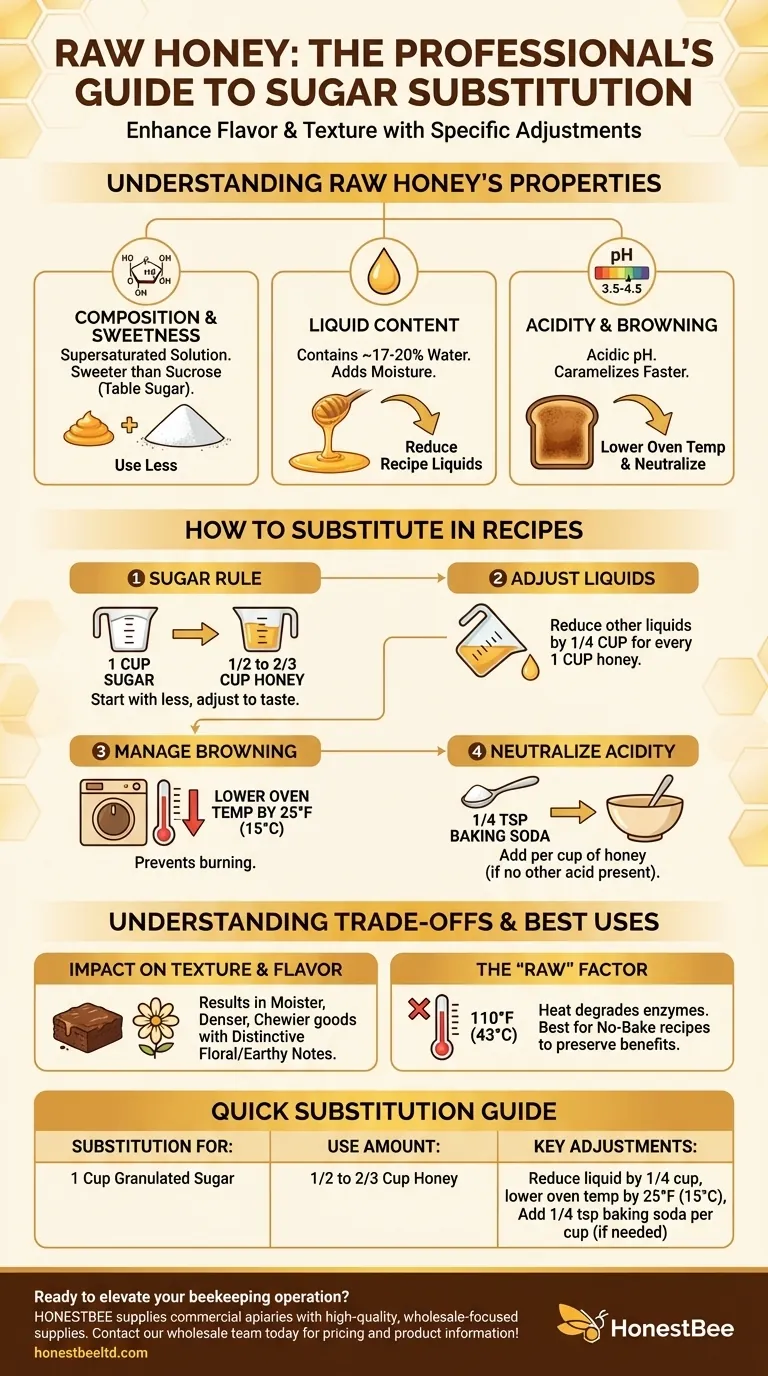Yes, you absolutely can. Raw honey is an excellent substitute for processed sugars and syrups in many recipes, but it is not a simple one-to-one swap. Because honey is sweeter, contains more liquid, and browns faster than granulated sugar, you must make specific adjustments to ensure a successful outcome.
The key to successfully substituting raw honey for sugar is to use less of it, reduce the other liquids in your recipe, and lower your oven temperature to compensate for its unique chemical properties.

Understanding Raw Honey's Properties
To substitute effectively, you must first understand why honey behaves differently than table sugar. Its composition dictates how it will interact with other ingredients in your recipe.
Composition and Sweetness
Raw honey is a supersaturated solution of primarily fructose and glucose. Fructose is significantly sweeter than sucrose (table sugar), which means you need less honey to achieve the same level of sweetness.
Liquid Content
Unlike dry, crystalline sugar, honey is a liquid. It contains approximately 17-20% water. Adding honey to a recipe without accounting for this moisture will result in a wetter, denser final product.
Acidity and Browning
Honey is naturally acidic, with a pH typically between 3.5 and 4.5. This acidity can interact with leavening agents like baking soda. Furthermore, the high fructose content causes honey to caramelize and brown much faster than sugar when heated.
How to Substitute Raw Honey in Recipes
With these properties in mind, you can use a few reliable guidelines to adapt almost any recipe.
The General Rule for Sugar
For every 1 cup of granulated sugar called for in a recipe, use 1/2 to 2/3 cup of honey. Start with less and adjust to your taste, as honey's sweetness can vary.
Adjusting Liquids
To compensate for the water in the honey, you must reduce the other primary liquids (like milk, water, or juice). A good rule is to reduce liquid by 1/4 cup for every 1 cup of honey you use.
Managing Browning
To prevent your baked goods from burning or becoming too dark on the outside before the inside is cooked, reduce the oven temperature by 25°F (about 15°C).
Neutralizing Acidity
In recipes that need to rise but do not contain another acid (like buttermilk or lemon juice), you may need to add a little baking soda to neutralize honey's acidity. Add 1/4 teaspoon of baking soda for every cup of honey used.
Understanding the Trade-offs
Substituting honey is not just a technical change; it alters the final product. Understanding these trade-offs is crucial for deciding when and where to use it.
Impact on Texture
Using honey typically results in a moister, denser, and chewier baked good. This is a desirable outcome for recipes like brownies and soft cakes but may be undesirable for things like crisp cookies or light, airy scones.
A Distinctive Flavor Profile
Honey is not a neutral sweetener. It will impart its own unique floral, fruity, or earthy notes to your dish. Choose a honey varietal that complements the other flavors in your recipe.
The "Raw" Consideration
If your goal is to preserve the beneficial enzymes and properties of raw honey, remember that heat degrades them. Heating honey above 110°F (43°C) diminishes its "raw" qualities. For this reason, raw honey is best used in no-bake recipes, dressings, smoothies, or as a finishing drizzle.
Making the Right Choice for Your Recipe
Use your final goal to determine if honey is the right substitute.
- If your primary focus is a moister, chewier texture: Honey is an excellent substitute in recipes for soft cookies, quick breads, and dense cakes.
- If your primary focus is flavor and natural sweetness: Use honey in recipes where its taste will be a welcome addition, such as in marinades, glazes, and whole-grain muffins.
- If your primary focus is a light, crisp, or delicate structure: Stick with granulated sugar for recipes like meringues, shortbread, or candy-making, where its crystalline structure is essential.
By understanding its properties and making the right adjustments, you can confidently use raw honey to enhance both the flavor and quality of your creations.
Summary Table:
| Substitution For | Use This Amount of Honey | Key Adjustments |
|---|---|---|
| 1 Cup Granulated Sugar | 1/2 to 2/3 Cup | Reduce liquid by 1/4 cup, lower oven temp by 25°F (15°C) |
| General Use | - | Add 1/4 tsp baking soda per cup of honey to neutralize acidity |
Ready to elevate your beekeeping operation? HONESTBEE supplies commercial apiaries and beekeeping equipment distributors with high-quality, wholesale-focused supplies and equipment. From honey extraction tools to protective gear, we provide the reliable resources you need to produce superior raw honey. Let's discuss how our products can support your business growth. Contact our wholesale team today for pricing and product information!
Visual Guide

Related Products
- Honeycomb Style Drip Free Honey Dispenser
- Stainless Steel Honey Press Wax Press with Tank
- HONESTBEE 3-Frame Manual Acrylic Honey Extractor
- 24 Frame Honey Extractor Commercial Radial Honey Frame Extraction Machine
- Professional Cone-Shaped Honey Filter with Reinforced Steel Ring
People Also Ask
- What are the benefits of squeeze bottles for honey packaging? Unlock Mess-Free Convenience & Control
- What is a honey dipper and what is it used for? A Guide to Mess-Free Drizzling
- Can a honey gate be reused, and how should it be stored? Ensure Longevity for Your Honey Harvests
- Why use a honey drizzler? Achieve Perfect, Mess-Free Drizzling Every Time
- Can we store honey in a stainless steel container? Yes, with the right food-grade choice.



















